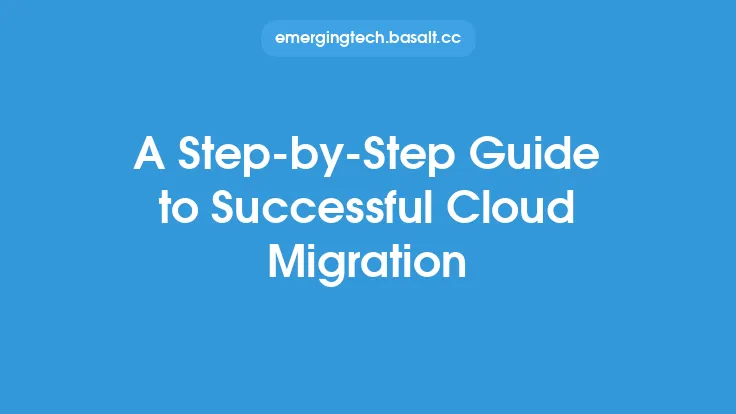Cloud infrastructure refers to the underlying systems and resources that enable cloud computing, allowing users to access and utilize computing resources over the internet. At its core, cloud infrastructure is a network of remote servers, data storage systems, and software applications that work together to provide on-demand computing services. This infrastructure is typically owned and operated by a third-party provider, who delivers these services to users over the internet.
Introduction to Cloud Infrastructure
Cloud infrastructure is designed to provide users with a scalable, flexible, and on-demand computing environment. This is achieved through the use of virtualization technologies, which allow multiple virtual machines to run on a single physical server. Each virtual machine is a self-contained environment with its own operating system, storage, and networking resources. Cloud infrastructure providers use a combination of hardware and software to create a large pool of computing resources, which can be dynamically allocated and deallocated as needed.
Characteristics of Cloud Infrastructure
Cloud infrastructure has several key characteristics that distinguish it from traditional on-premises computing environments. These include scalability, which allows users to quickly scale up or down to meet changing computing needs; flexibility, which enables users to choose from a range of computing resources and services; and multi-tenancy, which allows multiple users to share the same physical infrastructure. Cloud infrastructure also provides high levels of redundancy and failover, ensuring that computing services remain available even in the event of hardware or software failures.
Cloud Infrastructure Architecture
The architecture of cloud infrastructure typically consists of several layers, including the physical layer, the virtualization layer, and the service layer. The physical layer consists of the underlying hardware, including servers, storage systems, and networking equipment. The virtualization layer sits on top of the physical layer and provides a layer of abstraction, allowing multiple virtual machines to run on a single physical server. The service layer provides the actual computing services, including computing power, storage, and networking.
Cloud Infrastructure Deployment Models
Cloud infrastructure can be deployed in a variety of ways, including public, private, and hybrid models. Public cloud infrastructure is owned and operated by a third-party provider and is available to the general public. Private cloud infrastructure is owned and operated by a single organization and is not available to the general public. Hybrid cloud infrastructure combines elements of public and private cloud infrastructure, allowing users to choose the best deployment model for their specific needs.
Cloud Infrastructure Security
Cloud infrastructure security is a critical concern, as users are entrusting their computing resources and data to a third-party provider. Cloud infrastructure providers use a range of security measures to protect user data, including encryption, firewalls, and access controls. Users can also take steps to secure their cloud infrastructure, including using strong passwords, enabling two-factor authentication, and monitoring their accounts for suspicious activity.
Cloud Infrastructure Management
Cloud infrastructure management refers to the process of monitoring, managing, and optimizing cloud infrastructure to ensure that it is running efficiently and effectively. This includes tasks such as monitoring resource utilization, managing user accounts, and optimizing storage and networking resources. Cloud infrastructure providers typically offer a range of management tools and services to help users manage their cloud infrastructure, including web-based portals, command-line interfaces, and application programming interfaces (APIs).
Cloud Infrastructure and Networking
Cloud infrastructure and networking are closely intertwined, as cloud computing relies on networking to provide access to computing resources over the internet. Cloud infrastructure providers use a range of networking technologies, including virtual private networks (VPNs), load balancers, and content delivery networks (CDNs), to provide high-performance and secure networking services. Users can also use networking services to connect their cloud infrastructure to their on-premises computing environments, creating a hybrid cloud environment.
Cloud Infrastructure and Storage
Cloud infrastructure and storage are also closely related, as cloud computing relies on storage to provide access to data and applications over the internet. Cloud infrastructure providers use a range of storage technologies, including block storage, file storage, and object storage, to provide scalable and flexible storage services. Users can choose from a range of storage options, including storage area networks (SANs), network-attached storage (NAS), and cloud-based storage services.
Conclusion
In conclusion, cloud infrastructure is a complex and multifaceted concept that underlies the cloud computing paradigm. It provides users with a scalable, flexible, and on-demand computing environment, and is characterized by its use of virtualization technologies, multi-tenancy, and high levels of redundancy and failover. Cloud infrastructure can be deployed in a variety of ways, including public, private, and hybrid models, and is managed using a range of tools and services. As cloud computing continues to evolve and grow, cloud infrastructure will play an increasingly important role in enabling users to access and utilize computing resources over the internet.





